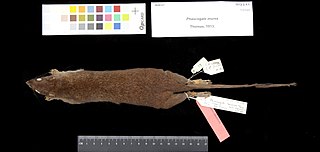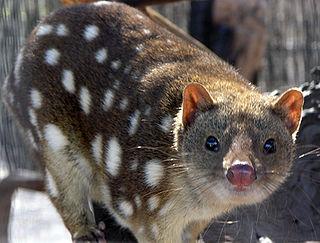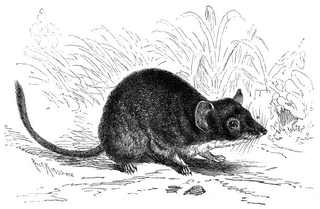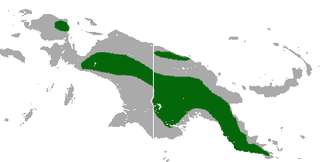
The Dasyuridae are a family of marsupials native to Australia and New Guinea, including 71 extant species divided into 17 genera. Many are small and mouse-like or shrew-like, giving some of them the name marsupial mice or marsupial shrews, but the group also includes the cat-sized quolls, as well as the Tasmanian devil and the extinct thylacine. They are found in a wide range of habitats, including grassland, underground, forests, and mountains, and some species are arboreal or semiaquatic. The Dasyuridae are often called the 'marsupial carnivores', as most members of the family are insectivores.

Mulgaras are the six small rat-sized species in the genus Dasycercus. They are marsupial carnivores, closely related to the Tasmanian devil and the quolls, that live in deserts and spinifex grasslands of arid Australia. They are nocturnal, but occasionally "sunbathe" in the entrance of the burrow in which they dwell. Their kidneys are highly developed to excrete extremely concentrated urine to preserve water, as the animals rarely drink. They feed mostly on insects, but also eat reptiles and small mammals. They are seasonal breeders and breed from June to September. The pouch comprises two lateral folds of skin.

The short-furred dasyure, also known as the short-haired marsupial mouse, is a member of the order Dasyuromorphia. It was once recognised as the only species in the genus Murexia, but now five species are recognised. It lives in Papua, Indonesia and Papua New Guinea.

The three-striped dasyure is a member of the order Dasyuromorphia. This marsupial carnivore lives in West Papua and Papua New Guinea.

Murexia is a genus of mouse-sized dasyure, in the marsupial order Dasyuromorphia. They are found in Papua, Indonesia and Papua New Guinea.

The tribe Dasyurini includes several genera of small carnivorous marsupials native to Australia: quolls, kowari, mulgara, kaluta, dibblers, neophascogales, pseudantechinuses, and the Tasmanian devil.

The Phascogalini are a tribe in the family Dasyuridae, comprising seven genera of small marsupials native to Australia and New Guinea.

Rory Cooper's false antechinus, also known as the tan false antechinus and the tan pseudantechinus, is a recently named species of small carnivorous marsupial which inhabits rocky outcrops in Western Australia. Nothing is known of its behaviour but it is expected that this will be similar to other members of the false antechinus genus. A study published in 2017 found no support for separation as a new species of Pseudantechinus, and the name was proposed to be synonymous with the previously described Pseudantechinus macdonnellensis.

The Habbema dasyure is a species of marsupial in the family Dasyuridae found in West Papua, Indonesia, and Papua New Guinea. Its natural habitat is rocky areas.

The black-tailed dasyure is a species of marsupial in the family Dasyuridae.

The long-nosed dasyure is a species of marsupial in the family Dasyuridae. It is found in Indonesia and Papua New Guinea. Its natural habitat is subtropical or tropical dry forests.

The broad-striped dasyure is a species of marsupial in the family Dasyuridae. It is endemic to Papua New Guinea. Its natural habitat is subtropical or tropical dry forests.

The narrow-striped dasyure or narrow-striped marsupial shrew is a species of marsupial in the family Dasyuridae found in West Papua and Papua New Guinea. Its natural habitat is subtropical or tropical dry forests.

The crest-tailed mulgara is a small to medium-sized Australian carnivorous marsupial and a member of the family Dasyuridae which includes quolls, dunnarts, the numbat, Tasmanian devil and extinct thylacine. The crest-tailed mulgara is among a group of native predatory mammals or mesopredators endemic to arid Australia.

Wallace's dasyure or Wallace's three-striped dasyure is a member of the order Dasyuromorphia. This marsupial carnivore is found in Indonesia and Papua New Guinea. Specifically, it is found on the Aru Islands of the Maluku Province of Indonesia.
The Tate's three-striped dasyure is a member of the order Dasyuromorphia. This marsupial carnivore lives in New Guinea. It inhabits primary montane forest. Like its congeners, it is thought to be diurnal and largely terrestrial.
Woolley's three-striped dasyure is a member of the order Dasyuromorphia. This marsupial carnivore lives in Papua New Guinea.
Patricia Woolley is Australian zoologist recognised for her work with marsupials, specifically the dasyurid family. Pseudantechinus woolleyae is named for her.
Woolley, P. 2005. Revision of the Three-striped dasyures, genus myoictis (marsupialia: dasyuridae), of New Guinea, with description of a new species.
Donnellan, S., Krajewski, C., Westerman, M., Woolley, P., Young, J., 2006. Molecular Relationships of New Guinean three-striped dasyures, (Myoictis, Marsupialia: Dasyuridae)














